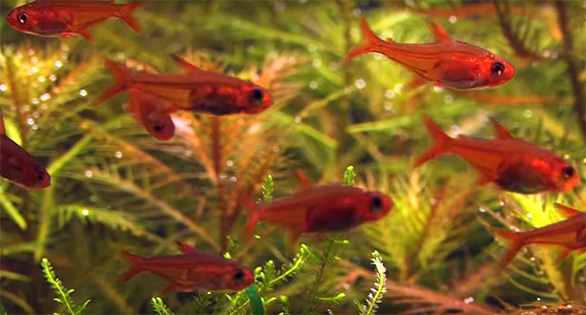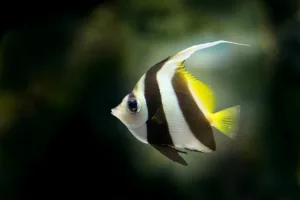Are you passionate about the captivating world of aquarium fishkeeping? If so, you’re in for a treat. Ember Tetras, with their fiery red-orange hues and peaceful demeanor, are a gem in the realm of ornamental fish.
In this comprehensive guide, we’ll take you on a journey through the secrets of Ember Tetras, covering everything from their natural habitat to expert care tips, breeding strategies, and the ideal aquarium setup.
Whether you’re a seasoned aquarist or just starting your aquatic adventure, join us as we dive into the vibrant universe of Ember Tetras, uncovering uncommon insights and valuable advice along the way.
| Aspect | Details |
|---|---|
| Lifespan | 2 to 4 years |
| Size | 0.75 to 1 inch (2 to 2.5 centimeters) |
| Appearance | Fiery red-orange with a flame mark |
| Preferred Water | pH 6.0-7.0, 73-82°F (22-28°C), soft to moderately hard water (2-10 dGH) |
| Scientific Name | Hyphessobrycon amandae |
| Suitable for Beginners | Yes |
| Tank Size | 10 gallons or more |
| Temperament | Peaceful, ideal for community tanks |

Ember Tetra Care Guide: A Fascinating Species
The Ember Tetra (Hyphessobrycon amandae) is a species of freshwater fish that has captured the hearts of aquarium enthusiasts worldwide. In this section, we will delve into a species summary, explore their lifespan, discuss their striking appearance, and understand their size, offering a comprehensive overview of these remarkable fish.
Species Summary
The Ember Tetra, native to the pristine waters of the Rio Araguaia in Brazil, is a petite but incredibly vibrant species. Named after the ember-like glow of its stunning red-orange coloration, these fish are known for their peaceful nature and their propensity to thrive in group settings. Within the aquarist community, they are often considered an excellent choice for both beginners and experienced hobbyists, thanks to their hardiness and adaptability to a wide range of aquarium conditions.
Lifespan
Ember Tetras are relatively short-lived when compared to some other aquarium fish species. On average, they have a lifespan of about 2 to 4 years when kept in optimal conditions. However, with exceptional care and ideal water parameters, some individuals have been known to exceed this average. Ensuring a well-maintained aquarium environment and a balanced diet can contribute significantly to the longevity of these charming fish.
Appearance
One of the most striking features of Ember Tetras is their vivid and fiery coloration. Their entire body, from the tip of their nose to the base of their tail, is adorned in vibrant shades of red and orange, resembling the warm glow of embers in a campfire. This dazzling coloration extends to their dorsal and anal fins, making them an eye-catching addition to any aquarium. Furthermore, their semi-transparent fins have a delicate, ethereal quality, enhancing their overall beauty.
Adding to their allure is a distinctive black mark that stretches from the center of their eye to the base of their caudal fin, creating a captivating contrast against their fiery backdrop. This mark, often referred to as the “flame mark,” adds a unique touch to their appearance, making them instantly recognizable among aquarists.
Size
Ember Tetras are small fish, with a size that adds to their charm. On average, adult Ember Tetras typically reach a length of around 0.75 to 1 inch (2 to 2.5 centimeters). While their diminutive size may not make them the focal point of a large aquarium, it is precisely their small stature that allows them to thrive in smaller tanks and community setups. Their petite size also encourages aquarists to keep them in schools, where their vibrant colors and social behavior can truly shine. Additionally, their small size makes them a suitable choice for aquarists with limited space or those looking to create a nano or planted tank, where their vivid hues can beautifully complement aquatic plants.
Ember Tetras are a captivating species of freshwater fish known for their striking appearance, including their fiery coloration and distinctive flame mark. With a lifespan of 2 to 4 years and a small size that ranges from 0.75 to 1 inch, they are a popular choice among aquarists of all levels of experience. These remarkable fish bring a touch of warmth and elegance to any aquarium, making them a beloved addition to the world of fishkeeping.
Aquarium Setup for Ember Tetras
Creating a suitable environment is paramount for the health and happiness of Ember Tetras.
Below, you’ll find a table outlining the essential parameters for their aquarium setup:
| Parameter | Range |
|---|---|
| Tank Size | 10 gallons or more |
| Temperature | 73-82°F (22-28°C) |
| pH Level | 6.0-7.0 |
| Hardness (dGH) | 2-10 |
| Lighting | Low to moderate |
| Filtration | Gentle flow |
| Substrate | Fine gravel or sand |
| Plants | Live plants preferred |
| Decorations | Driftwood, leaf litter |
Tank Size
Ember Tetras are small fish, but they are active swimmers and thrive in schools. A minimum tank size of 10 gallons is recommended, but larger tanks are even better. A larger tank provides more stability in water parameters and allows for a more significant school of these colorful fish.
Water Parameters
Maintaining stable water conditions is crucial for Ember Tetras. Keep the water temperature within the range of 73-82°F (22-28°C) and monitor the pH level, which should be between 6.0-7.0. A water hardness of 2-10 dGH is suitable.
Lighting
Ember Tetras come from shaded waters in their natural habitat. Therefore, it’s best to provide low to moderate lighting in the aquarium. This mimics their natural environment and helps reduce stress.
Filtration
Gentle filtration with a sponge filter or a low-flow filter is ideal. These tetras don’t appreciate strong currents, so make sure the filtration system is not too powerful.
Substrate and Plants
Ember Tetras prefer fine gravel or sand as substrate. Live plants such as Java Moss, Amazon Sword, and Hornwort are great additions to their tank. Plants not only provide hiding spots but also help maintain water quality.
Decorations
Adding driftwood and leaf litter can simulate their natural habitat further. Ember Tetras often seek refuge in these areas and graze on microorganisms living on the leaf litter.
Ember Tetra Diet
Proper nutrition is essential to keep Ember Tetras vibrant and healthy.
Here’s a table summarizing their dietary needs:
| Diet | Description |
|---|---|
| High-Quality Flakes | Staple diet, should contain protein and vitamins |
| Live or Frozen Foods | Brine shrimp, daphnia, and bloodworms |
| Vegetable Matter | Occasional servings of blanched spinach or lettuce |
| Microorganisms | They graze on microorganisms in the aquarium |
Ember Tetras are omnivores, and their diet should reflect this. High-quality flakes should make up the bulk of their diet. These flakes should contain protein and essential vitamins to ensure their overall health.
Supplement their diet with live or frozen foods like brine shrimp, daphnia, and bloodworms. These treats are rich in protein and replicate their natural diet in the wild.
Additionally, offering vegetable matter like blanched spinach or lettuce occasionally can provide essential fiber and nutrients.
Ember Tetras also graze on microorganisms present in the aquarium, so maintaining a well-balanced ecosystem with live plants and leaf litter is crucial.
Ember Tetra Behavior and Compatibility
Understanding the behavior and compatibility of Ember Tetras is key to creating a harmonious community tank. Below, we’ll discuss their behavior and suitable tankmates.
Behavior
Ember Tetras are peaceful and shoaling fish. They feel most secure when kept in groups of six or more. In smaller groups, they may become stressed and less active.
Observing their schooling behavior is a visual delight, as their vibrant colors create a mesmerizing display in the aquarium.
Tankmates
Selecting compatible tankmates is crucial to avoid aggression and ensure the well-being of your Ember Tetras.
Here’s a table listing suitable and unsuitable tankmates:
| Suitable Tankmates | Unsuitable Tankmates |
|---|---|
| Neon Tetras | Aggressive Cichlids |
| Corydoras Catfish | Large Predatory Fish |
| Dwarf Gouramis | Territorial Species |
| Rasboras | Large Angelfish |
| Small Tetra Species | Arowanas |
| Shrimp and Snails |
Ember Tetras thrive when kept with similarly peaceful and small fish. Compatible tankmates include Neon Tetras, Corydoras Catfish, Dwarf Gouramis, Rasboras, and other small Tetra species.
Avoid housing them with aggressive Cichlids, large predatory fish, territorial species, or large Angelfish, as these can stress or harm your Ember Tetras.
Shrimp and snails can also be added to the tank as they are unlikely to pose a threat and can help with aquarium maintenance.
Ember Tetra Breeding
Breeding Ember Tetras can be a rewarding experience. Below, we’ll discuss the requirements and steps involved in breeding these captivating fish.
Breeding Tank Setup
When breeding Ember Tetras, setting up a dedicated breeding tank is advisable.
| Parameter | Range |
|---|---|
| Tank Size | 10-20 gallons |
| Temperature | 78-80°F (25-27°C) |
| pH Level | 6.5-7.0 |
| Substrate | Marbles or mesh |
| Plants | Fine-leaved plants |
The breeding tank should be smaller than the main tank, ideally around 10-20 gallons in size. Maintain a temperature between 78-80°F (25-27°C) and a slightly higher pH level, typically around 6.5-7.0.
Use a substrate of marbles or mesh to protect the eggs from being eaten by adult fish. Fine-leaved plants such as Java Moss or spawning mops provide ideal hiding spots for the eggs.
Conditioning and Spawning
To encourage breeding behavior, provide the Ember Tetras with a well-balanced diet, including live and frozen foods. A separate conditioning period in the breeding tank can also stimulate their breeding instincts.
Ember Tetras are egg scatterers, meaning they do not care for their eggs or fry. Spawning usually occurs in the early morning hours when the female scatters eggs among plants or substrate. After spawning, remove the adult fish to prevent them from consuming the eggs.
Raising Fry
Once the eggs hatch, the fry can be fed infusoria or powdered fry food until they are large enough to consume micro worms or newly hatched brine shrimp. Maintain pristine water conditions and ensure the fry have access to hiding spots to reduce predation.
Common Health Issues and Care
Keeping your Ember Tetras healthy is of utmost importance. While they are generally hardy fish, they can still face some health issues. Here are some common problems and their remedies:
| Health Issue | Symptoms | Treatment |
|---|---|---|
| Ich (White Spot Disease) | White spots on the body and fins | Increase water temperature and use a suitable medication |
| Fin Rot | Torn, frayed fins | Isolate affected fish and treat with antibiotics |
| Swim Bladder Disorder | Difficulty swimming, floating upside down | Offer a diet high in fiber and avoid overfeeding |
| Stress | Reduced activity, color loss | Maintain stable water conditions and minimize stressors |
Maintaining excellent water quality is the best preventive measure against diseases. Regular water changes and proper filtration are essential.
In case of illness, swift action is crucial. Quarantine affected fish to prevent the spread of disease to the entire tank. Use appropriate medications or treatments as recommended by experts or a veterinarian specializing in fish health.










